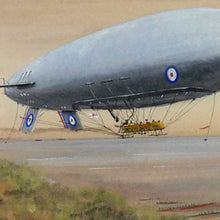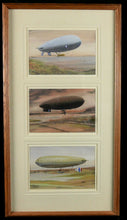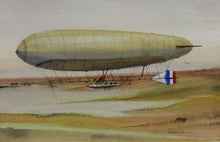British Airships, 1917-18 by Norman Wilkinson
- Regular price
- £1,450
- Sale price
- £1,450
- Regular price
-
- Unit price
- /per
Adding product to your cart
Overall: 73cm (28.7in) x 40cm (15.7in)
Watercolour and bodycolour on paper. Three studies of British dirigibles. From top to bottom: an SS Class Airship, signed ‘Norman Wilkinson [19]17’; SS 40 (The Black Ship), signed ‘Norman Wilkinson [19]18’; and, Willows No.4 (His Majesty's Airship No.2), signed ‘Norman Wilkinson [19]17’. Each: 14.9cm (5.8in) x 22.5cm (8.8in). Framed and glazed.
Read more
The three watercolours by the marine painter Norman Wilkinson illustrate the evolution of SS (Submarine Scout) Class Airships used to counter the German U-boat threat and detect and destroy mines during the First World War. The prototype SS craft, created at RNAS Kingsnorth on the Hoo Peninsula, utilised the envelope from His Majesty's Naval Airship No. 2 formerly known as Willows No.4 after its Welsh inventor Ernest Willows, combined with the fuselage and engine of a B.E.2c aeroplane slung below. The first SS class craft entered service in March 1915. Voicing his approval, Admiral Fisher made the famous comment: "Now I must have forty!” The SS class proved to be versatile and effective, with a total of 158 being built in several versions. SS 40 aka The Black Ship was a variant modified for night-time reconnaissance over German lines on the Western Front. Fitted with a silenced engine and a black gas bag, the craft was both invisible and inaudible from the ground.
The artist Norman Wilkinson CBE, RI (1878-1971) served in the Royal Naval Volunteer Reserve, during the First World War, taking part in submarine patrols in the Dardanelles and Gibraltar, and, beginning in 1917, in minesweeping at HMNB Devonport. In April 1917, when U-boats were sinking nearly eight merchant ships per day, he invented ‘dazzle camouflage’ for merchant ships and was placed in charge of a dedicated unit. In early 1918 he was assigned to Washington, D.C., to advise the U.S. Navy on the same. Already a successful marine artist before the war, Wilkinson was prolific poster artist throughout his life. He also competed in the art competitions at the 1928 and 1948 Summer Olympics. His painting titled ‘Plymouth Harbour’ for the first-class smoking room of the RMS Titanic, went down with the liner in 1912. He also created a comparable painting titled ‘The Approach to the New World’, which hung in the same location on the Titanic's sister ship, the RMS Olympic. He was appointed an Officer of the Order of the British Empire (OBE) in the 1918 New Year Honours, and a Commander of the Order (CBE) in the 1948 Birthday Honours. In January 1920 he was appointed knight (chevalier) of the Belgian Order of the Crown. Among many other hours he was elected Honourable Marine Painter to the Royal Yacht Squadron in 1919. During the Second World War he again recorded the work of the Royal Navy, the Merchant Navy and Coastal Command throughout the war. An exhibition of 52 of the resulting paintings, The War at Sea, was shown at the National Gallery in September 1944.











